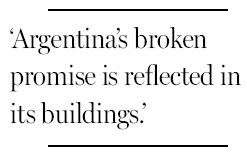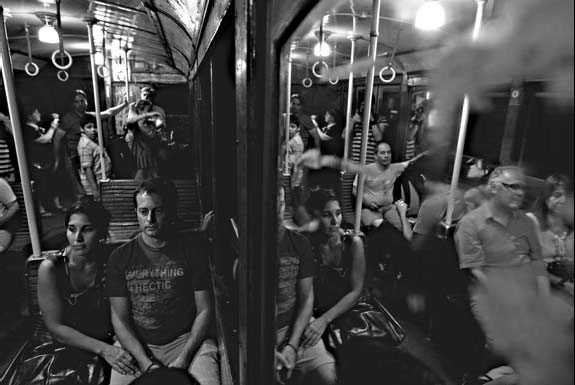Its architecture in decay, a city debates tradition
Updated: 2013-04-28 05:47
By Emily Schmall(The New York Times)
|
|||||||||
|
Passengers on a La Brugeoise train in Buenos Aires. Anibal Greco for The New York Times |
BUENOS AIRES - As Concepcion Martinez pulled into the last subway station here, cheers erupted from the throngs of people, some wearing turn-of-the-20th-century dress, waiting on the platform.
Camera flashes lighted the tunnels as passengers took their final rides in the wagons - with their wooden benches, frosted glass lamps and brass doors - of South America's first subway line.
"This is a kind of goodbye," Ms. Martinez said.
The Belgian-built cars, a symbol of Buenos Aires's early-20th-century wealth, were taken out of service this year, and their retirement is a poignant example of the city's struggle to preserve its history as some of its icons and infrastructure crumble.
The Buenos Aires subway was the first built in Latin America, and ahead of the systems in Madrid, Tokyo and Moscow.
At the time, Argentina was the world's ninth-richest country, according to the historic incomes database of the British economist Angus Maddison.
In 1910, newspapers in 80 languages were available in Buenos Aires. The city had the region's biggest zoo and a well-regarded research center on infectious diseases. Argentina's gross domestic product per capita was nearly twice that of Spain's and nearly five times bigger than Brazil's, according to the database.
Decades of fighting seized lands from the indigenous Patagonians and greatly expanded Argentina's agricultural opportunities in the country's south. The ensuing economic bonanza fueled by beef and grain exports, which continue to be core industries here, drew millions of immigrants from Europe.
The most successful among them flaunted their good fortune by commissioning famous European architects. Immigrants financed opera houses modeled after those in Vienna and Paris, and the world's biggest Edwardian train terminal.
An audit last fall cautioned that much of Buenos Aires's underground transit system was in a dangerous state of disrepair, and that the city's oldest line should be removed from service. "Maintenance is not considered adequate," the audit said.

The reaction against the retirement of the La Brugeoise trains, known affectionately as Las Brujas, or the witches, has fueled a debate. "They want to modernize and expand, but they haven't considered how the trains move people emotionally," said Gerardo Gomez Coronado, who oversees architectural protection at the city's planning department.
Many historic buildings have been demolished since Argentina's economic collapse in 2001. Preservationists say illegal demolitions, chronic underinvestment and the unimaginative architecture that is replacing the historic buildings threaten to erase the city's heritage as a mecca for European immigrants.
"Argentina promised to be a very, very important country," said Teresa Anchorena, an artist and member of the National Commission of Museums, Monuments and Historic Places. "Argentina's broken promise is reflected in its buildings."
The poor state of countless once-grand homes across Buenos Aires is testament to years of political and economic upheaval, Ms. Anchorena said. "What's happened to these buildings is a little like what's happened to Argentina," she said.
The subway cars now sit on a vacant lot, and some have been vandalized, with pieces torn off and hawked over the Internet.
But Alberto Rosenblatt, who has played the violin in Buenos Aires's oldest subway stop for years, said he was not nostalgic about the old trains.
"They are already 100 years old," he said. "This is an opening for another 100 years, but of progress, not regression. We will not always be looking backward."
The New York Times
(China Daily 04/28/2013 page12)
